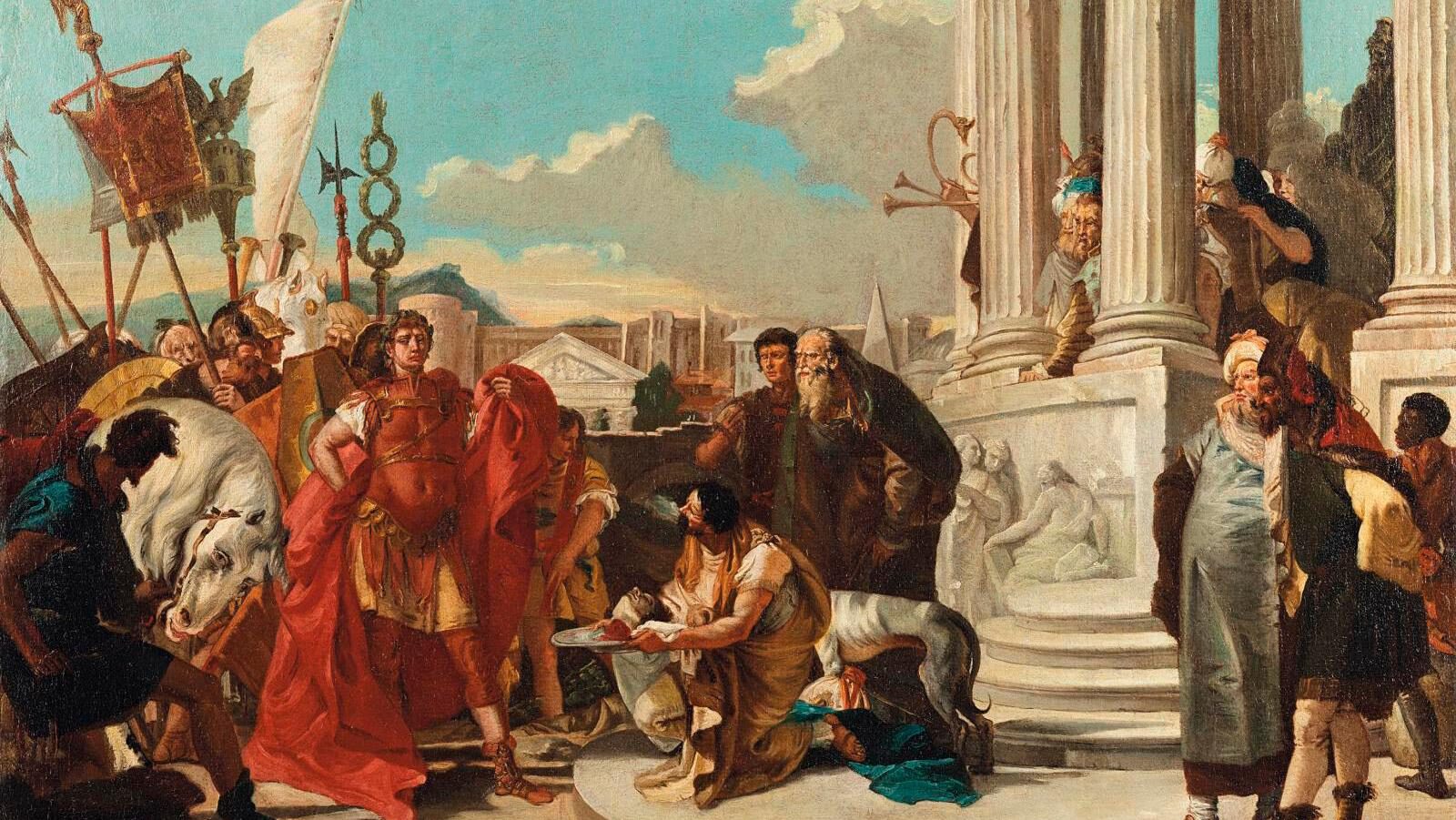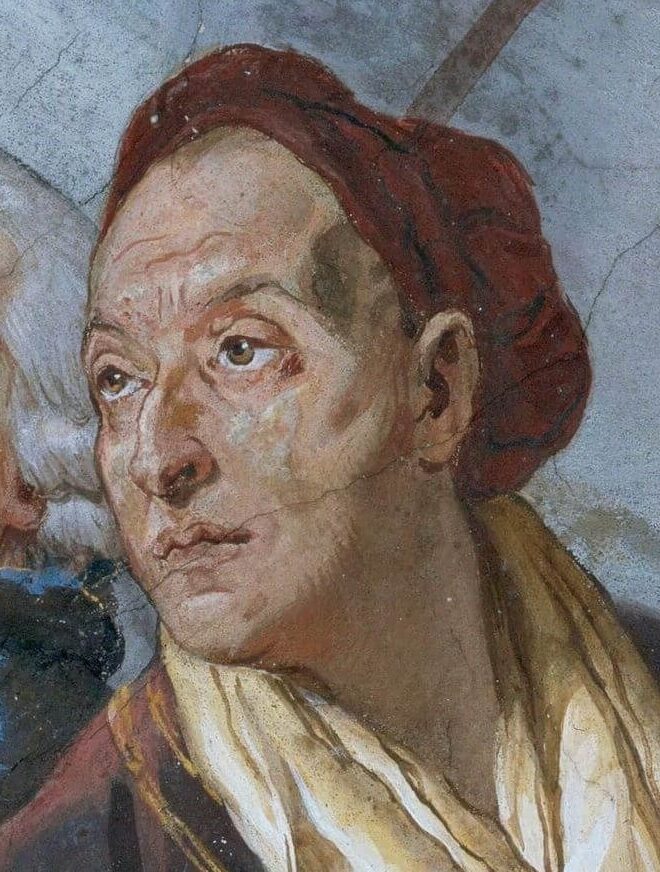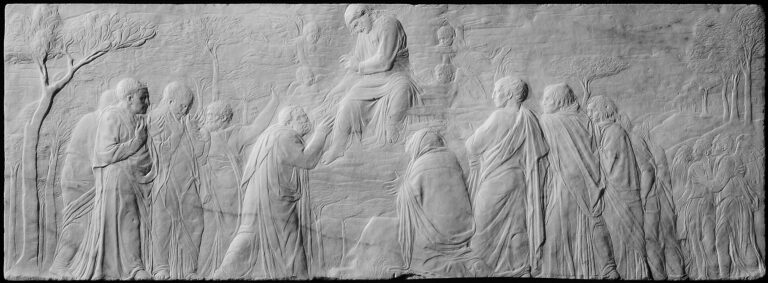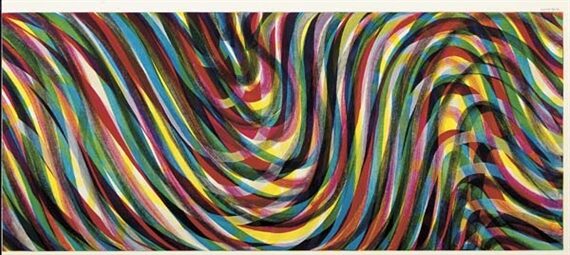Giovanni Battista Tiepolo Painter: Masterful Venetian Artist of the Rococo Period
Born: 5 March 1696, Venice, Venetian Republic
Death: 27 March 1770, Madrid, Spain
Mouvement artistique : Rococo
Nationalité : Italien
Teacher: Gregorio Lazzarini
Giovanni Battista Tiepolo Painter: Masterful Venetian Artist of the Rococo Period
Life and Career of Giovanni Battista Tiepolo
Giovanni Battista Tiepolo was one of the most important Italian painters of the 18th century. His brilliant career spanned from Venice to Madrid, where he created magnificent frescoes and paintings that embodied the height of Rococo style.
Petite enfance et formation
Born in Venice in 1696, Tiepolo grew up in a city famous for its artistic heritage. As a young man, he studied under Gregorio Lazzarini, a respected Venetian painter who taught him classical techniques.

The Banquet of Cleopatra (1743–1744) by Giovanni Battista Tiepolo
Tiepolo quickly developed his own distinctive style that combined elements of the Baroque period with lighter colors and more dynamic compositions.
By his early twenties, he was already receiving important commissions in Venice.
His early works showed remarkable talent for storytelling through art. He married Maria Cecilia Guardi in 1719, starting a family that would include several children who later became artists themselves.
Venice’s unique light and colorful atmosphere heavily influenced his painting style. He became known for his ability to create the illusion of open, airy spaces with bright skies.
Major Works and Commissions
Tiepolo’s reputation grew rapidly, leading to prestigious commissions throughout Italy and Europe. His masterful frescoes adorned palaces, churches, and villas of wealthy patrons.

Rinaldo Enchanted by Armida (1742–1745) by Giovanni Battista Tiepolo
Among his most celebrated works are the ceiling frescoes at the Würzburg Residence in Germany, completed between 1750-1753. These massive paintings showcase his genius for creating dramatic, heavenly scenes that seem to open the ceiling to the sky.
In Venice, his work at the Ca’ Rezzonico and the Palazzo Labia demonstrates his skill with both religious and mythological subjects. He painted with extraordinary speed and confidence.
Tiepolo’s paintings feature distinctive characteristics:
- Luminous colors, especially blues and pinks
- Dramatic perspectives that create illusions of depth
- Theatrical compositions with figures floating in cloudy skies
Dernières années et influence
In 1762, Tiepolo accepted an invitation from King Charles III to work in Madrid. He spent his final years creating ceiling frescoes for the Royal Palace, competing with other artists like Anton Raphael Mengs.
The rising popularity of Neoclassicism began to overshadow Tiepolo’s more decorative Rococo style during this period. Yet he continued working in his signature style until his death in Madrid in 1770.
His influence extended through his sons, Domenico and Lorenzo, who carried on his artistic legacy. Many later artists studied his techniques for creating dramatic lighting and perspective.
Though his popularity diminished briefly after his death, Tiepolo was rediscovered in the 19th century and is now recognized as the last great painter of the grand Italian decorative tradition.
Style artistique et thèmes
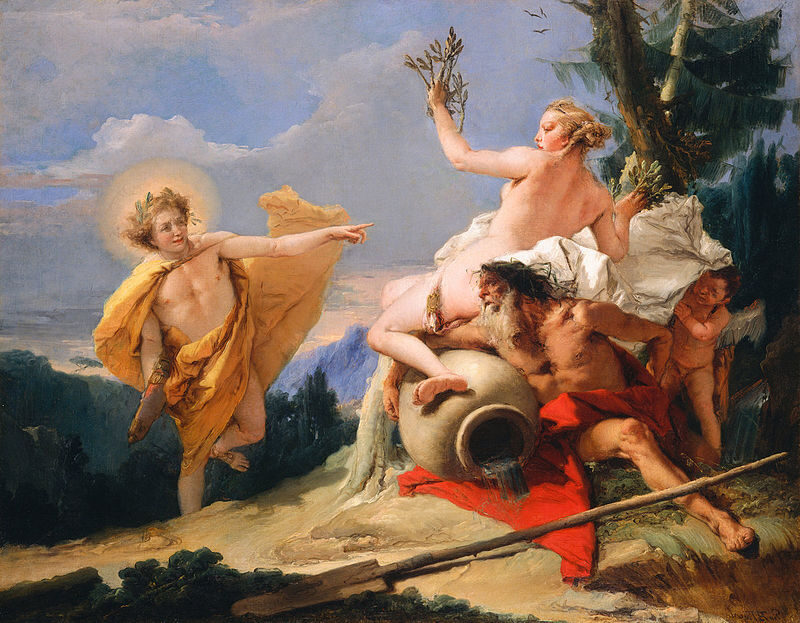
Apollo Pursuing Daphne (1755–1760) by Giovanni Battista Tiepolo
Giovanni Battista Tiepolo developed a distinctive artistic style that combined technical virtuosity with dramatic compositions. His work bridged the Baroque and Rococo periods, creating a unique visual language that influenced generations of artists.
The Rococo and Baroque Influence
Tiepolo’s style incorporated elements from both Baroque and Rococo traditions, creating a distinctive artistic approach. From the Baroque, he embraced dramatic compositions, strong contrasts, and emotional intensity. His work featured the characteristic chiaroscuro technique – bold contrasts between light and shadow that added depth and drama.
The Rococo influence appeared in his lighter color palette, decorative elements, and sense of playfulness. Unlike the heavier Baroque style, Tiepolo’s work often displayed a sense of buoyancy and grace with airy compositions and pastel colors.
His ceiling frescoes perfectly showcased this blend, combining grand religious or mythological scenes with ornamental details and lightness that defined the Rococo aesthetic. This fusion helped Tiepolo create works that felt both substantial and ethereal.
Iconographie et symbolisme
Tiepolo excelled at storytelling through carefully chosen iconography and symbols. He frequently depicted classical mythology, religious narratives, and historical scenes with rich symbolic elements.


In works like “Apollo and Daphne” and “Rinaldo Abandons Armida,” Tiepolo used mythological subjects to explore human emotions and spiritual themes. His religious works, including “The Sacrifice of Abraham,” demonstrated his ability to capture intense devotional moments through dramatic composition and emotional expression.
Tiepolo’s paintings often featured recurring elements:
- Billowing clouds and celestial light
- Architectural elements from multiple periods
- Exotic costumes and figures
- Symbolic objects that reinforced narrative meaning
These symbolic choices reflected the artistic concept of “capriccio” (artistic caprice) that Tiepolo embraced, allowing for imaginative departures from strict historical accuracy.
Techniques et innovations
Tiepolo’s technical brilliance set him apart from contemporaries. His mastery of fresco painting allowed him to create grand ceiling works with remarkable visual impact and depth.
His innovative approach to composition often featured:
- Dramatic foreshortening and perspective
- Diagonal arrangements that guided the viewer’s eye
- Strategic placement of light sources
- Figures that seemed to float beyond architectural boundaries
Tiepolo developed a rapid, confident brushwork technique that conveyed energy and movement. His palette featured luminous colors that maintained their vibrancy even in large-scale works.
He pioneered new approaches to ceiling frescoes by creating illusionistic spaces where walls seemed to open to infinite skies. This technique, called “di sotto in sù” (from below to above), created breathtaking visual effects that transformed architectural spaces.
Œuvres notables et héritage
Tiepolo’s artistic legacy spans magnificent frescoes in grand European palaces to intimate peintures à l'huile that demonstrate his mastery of light and color. His works show remarkable versatility and technical brilliance that influenced generations of artists throughout Europe.
Palazzo Labia and Würzburg Residency
The frescoes at Palazzo Labia in Venezia represent one of Tiepolo’s most spectacular achievements. Completed around 1740, these works feature scenes from the life of Cleopatra, displaying his talent for creating illusionistic spaces filled with drama and elegance.

The Sacrifice of Iphigenia (1757) by Giovanni Battista Tiepolo
In Germany, Tiepolo created his masterpiece at the Würzburg Residency between 1750-1753. The ceiling of the Kaisersaal (Imperial Hall) presents a breathtaking vision of Apollo and the four continents. His work in the magnificent staircase hall depicts allegories celebrating the achievements of Prince-Bishop Carl Philipp von Greiffenklau.
These frescoes show Tiepolo’s unmatched ability to organize complex scenes with multiple figures in believable atmospheric space. His color palette at Würzburg—featuring luminous blues and pinks—became his signature style.
The Royal Palace in Madrid and Final Projects
In 1762, Tiepolo traveled to Madrid at the invitation of King Charles III to decorate the Royal Palace. The spectacular ceiling fresco “The Apotheosis of the Spanish Monarchy” demonstrates his mature style with its airy compositions and virtuoso technique.
Despite facing competition from Anton Raphael Mengs, whose neoclassical approach was gaining favor, Tiepolo completed several important works in Madrid. His ceiling paintings for the Guard Room and the Throne Room remain outstanding examples of his decorative genius.
During this final period, Tiepolo also created notable oil paintings including religious works for Spanish churches. His son Domenico assisted him on many of these projects. Tiepolo remained active until his death in Madrid in 1770, never returning to his beloved Venice.
Tiepolo’s Impact on European Art
Tiepolo’s influence extended throughout Europe’s artistic centers. His works can be found in major museums worldwide, including the National Gallery in London, the Frick Collection in New York, and Museum of Fine Arts in various cities.

Sketch for Venus and Vulcan (1765–1766) by Giovanni Battista Tiepolo
His bold compositions inspired later Venetian artists and his techniques influenced ceiling painting throughout Europe. Tiepolo’s dramatic foreshortenings and luminous colors impressed contemporaries and later generations alike.
Collectors in Saint Petersburg, Vienna, and Munich eagerly acquired his works. His oil sketches, prized for their spontaneity, became highly sought after, with fine examples now in the Yale University Art Gallery and Ca’ Rezzonico in Venice.
Tiepolo’s legacy lies in his ability to modernize the Baroque tradition while maintaining its theatrical grandeur. His paintings combine technical virtuosity with poetic imagination, creating visual experiences that continue to captivate viewers today.
Questions fréquemment posées
Giovanni Battista Tiepolo was a master of Venetian Rococo painting whose work continues to inspire curiosity. His innovative techniques, distinctive color palette, and artistic evolution made him one of the 18th century’s most important painters.
What were Giovanni Battista Tiepolo’s most influential works?
Tiepolo’s most influential works include his magnificent ceiling frescoes. The “Allegory of the Planets and Continents” at the Würzburg Residence in Germany stands as a masterpiece of perspective and composition.
His “The Triumph of Marius” and “The Banquet of Cleopatra” showcase his ability to blend historical subjects with dramatic flair. These works influenced generations of artists through their luminous quality and theatrical arrangements.
The “Apollo and the Continents” ceiling in Würzburg demonstrated his skill in creating illusionistic spaces that seemed to extend architecture into the heavens.
How did Giovanni Battista Tiepolo impact the Rococo movement?
Tiepolo elevated the Rococo style by combining it with the grandeur of Baroque traditions. His light palette and airy compositions became hallmarks of 18th-century decorative painting.
Unlike many Rococo artists focused solely on ornamental beauty, Tiepolo maintained narrative strength in his work. He brought a theatrical sense to ceiling paintings that transformed interior spaces.
His international commissions spread Venetian artistic influence throughout Europe, from Spain to Germany.
Can you explain the significance of the ‘Tiepolo blue’ in his paintings?
The famous “Tiepolo blue” refers to the distinctive azure sky color that appears in many of his works. This luminous, pale blue creates a sense of infinite space and heavenly atmosphere in his ceiling frescoes.
This color innovation helped Tiepolo achieve his remarkable illusions of depth. The blue contrasts with warmer foreground colors, pushing architectural elements and human figures forward.
Tiepolo’s mastery of this color contributed to his reputation for creating light-filled compositions that seem to dissolve solid ceilings into expansive skies.
What techniques did Giovanni Battista Tiepolo use in his frescoes?
Tiepolo developed a rapid painting technique that allowed him to complete large-scale works efficiently. He often worked directly on wet plaster with minimal preparatory drawings beneath.
His distinctive method included applying thin, transparent layers of paint to achieve luminosity. Rather than heavy shadows, he used light touches and reflections to create depth.
Tiepolo mastered foreshortening to create dramatic perspectives when viewed from below. This skill made his ceiling paintings appear three-dimensional and dynamic.
What are some notable examples of Giovanni Battista Tiepolo’s religious art?
Tiepolo’s “Martyrdom of St. Bartholomew” demonstrates his ability to blend religious devotion with dramatic composition. His altarpiece “The Immaculate Conception” shows his skill in depicting spiritual subjects with ethereal light.
The ceiling fresco of “The Triumph of Faith” in Venice’s Church of the Pietà showcases his talent for religious narratives. He painted numerous scenes from the lives of saints with emotional intensity and visual clarity.
His religious works often placed biblical figures in luminous, cloud-filled heavens that conveyed divine presence.
How has Giovanni Battista Tiepolo’s art style evolved throughout his career?
Tiepolo’s early work showed strong influence from Venetian masters like Veronese. During this period, his paintings featured richer colors and more defined forms.
As his career progressed, his palette lightened considerably. By his middle career, he developed the airy, luminous style that became his signature.
In his final years working in Spain, Tiepolo adapted to changing tastes. His later works maintained technical brilliance but sometimes incorporated more restrained compositions to accommodate the evolving preferences of royal patrons.

